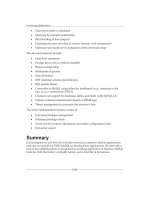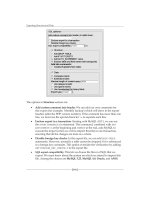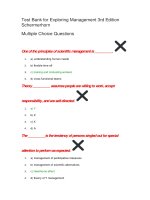Exploring management 3rd ch09
Bạn đang xem bản rút gọn của tài liệu. Xem và tải ngay bản đầy đủ của tài liệu tại đây (956.04 KB, 22 trang )
Exploring Management
Chapter 9
Organizational Cultures,
Innovation, and Change
Chapter 9
•
•
•
What is the nature of organizational culture?
How do organizations support and achieve innovation?
How do manages lead the processes of organizational change?
9.1
Organizational Culture
•
•
•
Organizational culture is the personality of the organization
•
•
The core culture is found in the underlying values of the organization
Organizational culture shapes behavior and influences performance
The observable culture is what you see and hear as an employee or
customer
Value-based management supports a strong organizational culture
ORGANIZATIONAL CULTURE
Organizational Culture
•
Culture is the personality of the organization
– Shared beliefs and values that guide behavior of organization members
ORGANIZATIONAL CULTURE
Strong Cultures
•
Organizational culture shapes behavior and influences performance
– Strong cultures are clear, well defined and widely shared among members
– Socialization helps new
members learn the
culture
ORGANIZATIONAL CULTURE
Observable Culture
•
Observable culture is what you see and hear
ORGANIZATIONAL CULTURE
Organizational Culture
•
•
Core culture is the underlying values of the organization
Core values are the beliefs that shape behavior
ORGANIZATIONAL CULTURE
Values
•
Values based management works hard to make sure the core values
show
•
Symbolic leaders use language and symbols to establish and reinforce
organizational culture
ORGANIZATIONAL CULTURE
Workplace Spirituality
•
Workplace spirituality involves creating meaning and community for
employees
– Common elements are meaningful work, respect for diversity, work life balance
and ethical behavior
– Symbolic leaders model and teach the culture and values
9.2
Innovation
•
•
•
•
•
Organizations pursue process, product and business model innovations.
Green innovations pursue and support the goals of sustainability.
Social innovations seek solutions to important societal problems.
Commercializing innovation turns new ideas into stable products.
Innovative organizations share many common characteristics.
Innovation
Types of Innovation
•
Innovation – taking a new idea and putting it into practice
– Process innovation results in better ways to do things
– Product innovation results in new or improved goods or services
– Business model innovations are new ways to make money
Innovation
Types of Innovation
•
Green innovations
– Earth friendly business models
•
Social innovations
– Business models that help solve the world’s social problems
•
Social Entrepreneurship
– Ways to solve social
problems
Innovation
Commercializing Innovation
•
Commercializing innovation
– Turns ideas into products, services or processes
Innovation
Commercializing Innovation
•
Reverse innovation
– takes products created for small or emerging markets and moves them into
larger distribution
Innovation
Innovative Organizations
Characteristics of highly innovative organizations
Strategy includes
Culture values
Structures support
Management supports
Staffing for creativity
innovation
innovation
innovation
innovation
and innovation
9.3
Leading Change
•
•
Organizations pursue both transformational and incremental changes.
Three phases of planned change are unfreezing, changing and
refreezing.
•
Managers use force-coercion, rational persuasion, and shared power
change strategies.
•
Change leaders identify and deal positively with resistance to change.
Organizational Change
Types of Change
•
Change leaders
– Leaders who take responsibility for change
Organizational Change
Types of Change
•
Transformational change
– Results in major and comprehensive redirection of the organization
•
Incremental change
– Smaller change that aligns systems and practices with strategy
Organizational Change
Change Process
Kurt Lewin
described change as
a three part process
Organizational Change
Strategies for leading change
9.3
Organizational Change
•
Change leaders identify and deal positively with resistance to change
– Positive tactics
•
•
•
•
Education and communication
•
•
Manipulation and cooptation
Participation and involvement
Facilitation and support
Negotiation and agreement
– Negative resistance tactics
Explicit and implicit coercion
9.3
Organizational Change
•
Why people resist change
•
•
•
•
•
•
•
•
Fear of the unknown
Disrupted habits
Loss of confidence
Loss of control
Poor timing
Work overload
Loss of face
Lack of purpose









